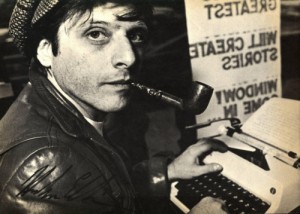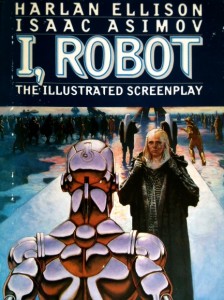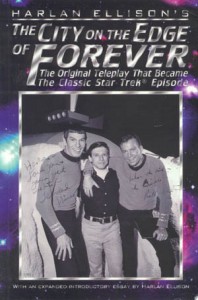 He’s one of the most revered—and sometimes controversial—writers of speculative fiction (and God help you if you call him just “a science-fiction writer”); a man who trademarked his name (hence the registration mark in the header up top), and whose work in prose, film, television, and comics has served as inspiration for at least one generation of writers that includes J. Michael Straczynski, creator of Babylon 5.
He’s one of the most revered—and sometimes controversial—writers of speculative fiction (and God help you if you call him just “a science-fiction writer”); a man who trademarked his name (hence the registration mark in the header up top), and whose work in prose, film, television, and comics has served as inspiration for at least one generation of writers that includes J. Michael Straczynski, creator of Babylon 5.
Today is Harlan Ellison’s 80th birthday, and here’s the story of my first encounter with him. Get comfortable; it’s kinda lengthy.
It was late 1994, and I was working as an assistant editor at Byron Preiss Visual Publications, a book packaging company that created science fiction, fantasy, and comic book projects that publishers paid to release. Byron Preiss and Howard Chaykin’s 1970s graphic novel adaptation of Alfred Bester’s The Stars My Destination, released by Baronet Publications, is one example of BPVP projects; the 1990s comic adaptation of the first three Hitchhiker’s Guide to the Galaxy novels, published by DC Comics, is another.
At the time, I’d been there for only a few months, and was still feeling my way through the job. I’d never been in real publishing before; the reason I got hired for BPVP was because the Human Resources person saw on my résumé that I self-published comics (Lorelei) and assumed that I knew all stages of production. So my attitude was, keep your head down, do your job, learn what you can from your immediate supervisor (senior editor Howard Zimmerman, who taught me a lot and years later edited my first Pandora Zwieback novel, Blood Feud), and try not to do anything that would embarrass yourself or (worse) the company.
 And then one day, the comic adaptation of I, Robot landed on my desk. It was a planned miniseries adapting I, Robot: The Illustrated Screenplay—a trade paperback edition of a “lost” screenplay that Ellison had written in the early 1980s, based on Isaac Asimov’s classic short-story collection. (And by “lost” I mean the movie studio executives who had commissioned the work had shelved the project and put the screenplay into storage, until Ellison convinced them to let it be released in book form.) The comic version had been going through a start-and-stop production schedule when I came along, mostly because it was to be a series painted by the screenplay’s illustrator Mark Zug—who had never done comic work before—and painting comic pages takes a lot of time (just ask Alex Ross). Now it was on again.
And then one day, the comic adaptation of I, Robot landed on my desk. It was a planned miniseries adapting I, Robot: The Illustrated Screenplay—a trade paperback edition of a “lost” screenplay that Ellison had written in the early 1980s, based on Isaac Asimov’s classic short-story collection. (And by “lost” I mean the movie studio executives who had commissioned the work had shelved the project and put the screenplay into storage, until Ellison convinced them to let it be released in book form.) The comic version had been going through a start-and-stop production schedule when I came along, mostly because it was to be a series painted by the screenplay’s illustrator Mark Zug—who had never done comic work before—and painting comic pages takes a lot of time (just ask Alex Ross). Now it was on again.
My job was to go through the first issue—which had already been completed before I started working at BPVP—and proofread it for any errors. One of the first things to check was what’s called an “author ad card”: that’s the page you see in a typical novel that’s usually headed “Also by [author name]” or “Other Works by [author name].” It’s a promotional list of their published works. Like most authors, Ellison had an ad card, only his included titles that hadn’t been published yet.
 Harlan Ellison’s The City on the Edge of Forever was one of them.
Harlan Ellison’s The City on the Edge of Forever was one of them.
When I saw it listed I thought, that doesn’t look right. Of course I knew what “City on the Edge of Forever” is: one of the most famous episodes of the original Star Trek series. Kirk, Spock, and McCoy time-travel to 1930s New York and debate whether guest star Joan Collins should die in order to preserve the future. And I was familiar with the story of how, even though it won awards, Ellison wasn’t happy with the finished product because it took too many liberties with what he’d delivered to Gene Roddenberry. But where did this book listing come in? I went to Howard and explained my confusion.
“You know what this means, right?” Howard asked. “You’re going to have to call Harlan.”
Well, that’s not what I wanted to hear. The only thing more famous than Ellison’s works was his reputation for, as the saying goes, not suffering fools gladly. Hell, one of his real-life tales involved him flying cross-country to confront a magazine editor who’d reprinted—and edited—a story without Ellison’s permission. A chase through the magazine’s offices ensued, with Ellison climbing up on the guy’s desk to deliver some choice words—and then making tracks out of there before the cops arrived. And there was the occasion when, during a college speaking tour, he smacked a local drug dealer in the face with a microphone after calling out the guy and daring him to come onstage (I heard Ellison tell this story at a convention I attended in the late eighties). Those more adventurous days might be behind him, but intellectually he could still beat the living crap out of you.
So I called his house, and his wife Susan picked up. Excellent! Maybe I could get what I needed without ever bringing Ellison into the conversation. I explained my situation and asked if she knew what the listing pertained to. And then she said:
“Let me get Harlan for you.”
“No, that’s okay—”
She put me on hold.
Crap. So I waited, expecting the worst. There was the click of an extension being picked up, and Harlan Ellison uttered his first-ever words to me:
“What the f*** do you want?”
Oh boy.
“Hi, Mr. Ellison, my name is Steve Roman, and—”
“My father was ‘Mr. Ellison.’ Call me Harlan.”
Uhhh…
“Okay. Well, I was calling because I was going over the ad card for the I, Robot comic and I saw City on the Edge of Forever listed as one of the books. I just wanted to confirm that.”
“Well, tell me, Steve, what’s the first thing you think of when you hear the title ‘City on the Edge of Forever’?”
“An old Star Trek episode?” I winced, afraid that I’d set him off by referring to one of his most famous works as “old.”
“Right,” he said, then explained that before that it was a teleplay (of course), and this book was a collection of his original drafts. “Only the release date got moved because Roddenberry went and died on me before I could finish the introduction. Now I’m revising it.”
Oohhhh. Okay. That explained everything. The rest of the phone call passed pleasantly, especially since he was excited about the comic returning to the production schedule, and my first encounter with Mr. Elli— Harlan ended on a positive note. Not such a bad guy, I thought. 😉
There were other occasions during my decade at BPVP when I got to interact with Harlan:
 The time I was editing the kids’ anthology Bruce Coville’s UFOs and wanted to include a Harlan story (I was on a mission to introduce younger readers to some of science fiction’s greatest writers). He immediately thought of “A Lot of Saucers,” a story he wrote in the 1950s “before I became Harlan Ellison.” I made a few minor edits that he agreed with, and he was so pleased with the results that he had the story reprinted in a later collection, Harlan Ellison’s Troublemakers.
The time I was editing the kids’ anthology Bruce Coville’s UFOs and wanted to include a Harlan story (I was on a mission to introduce younger readers to some of science fiction’s greatest writers). He immediately thought of “A Lot of Saucers,” a story he wrote in the 1950s “before I became Harlan Ellison.” I made a few minor edits that he agreed with, and he was so pleased with the results that he had the story reprinted in a later collection, Harlan Ellison’s Troublemakers.
 The time I was supervising a digital collection of Will Eisner’s Spirit comic adventures, with a producer who raised the notion of creating a radio-style audio adaptation of one of the stories. Harlan found out, then proceeded to audition for me over the phone as the narrator, the Spirit, and the Spirit’s politically incorrect African-American sidekick, Ebony White!
The time I was supervising a digital collection of Will Eisner’s Spirit comic adventures, with a producer who raised the notion of creating a radio-style audio adaptation of one of the stories. Harlan found out, then proceeded to audition for me over the phone as the narrator, the Spirit, and the Spirit’s politically incorrect African-American sidekick, Ebony White!
And the time I suggested reprinting the I, Robot screenplay to take advantage of the forthcoming Will Smith film of the same title (but which had nothing to do with adapting any of Asimov’s works). When Harlan asked me why I’d proposed this, our conversation went like this:
“Well, I figured that people who go to the Will Smith movie will see it and buy it, thinking it’s the screenplay for that. By the time they figure out it’s not, we’ve already got their money.”
Long pause. Then: “Y’know, I used to like you, kid. But, okay.”
Happy birthday, Harlan!
(And folks, if you get the chance, check out the documentary Harlan Ellison: Dreams with Sharp Teeth. It’s a fascinating look at Harlan and his work, and features guest appearances by a carload of his famous friends.)







Pingback: Star Trek: City on the Edge of Forever Review at Comics for Sinners | StarWarp Concepts
Pingback: Rest in Peace, Harlan Ellison | StarWarp Concepts